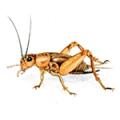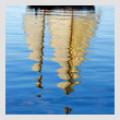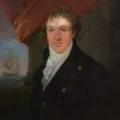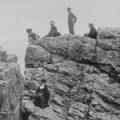Mary King Longfellow paints Monhegan
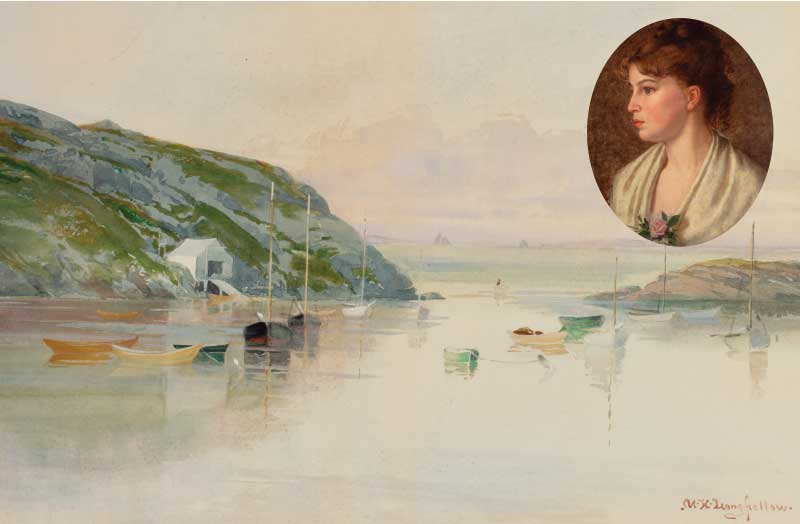 Mary King Longfellow’s Monhegan Harbor captures her style as a watercolorist and preference for a subdued palette. (INSERT) In Ernest Longfellow’s portrait, Mary King Longfellow, we meet the artist as a young woman. (Background painting) Collections of the Maine Historical Society, 2002.064 (Portrait, at right) Collections of the Maine Historical Society, A85-520
Mary King Longfellow’s Monhegan Harbor captures her style as a watercolorist and preference for a subdued palette. (INSERT) In Ernest Longfellow’s portrait, Mary King Longfellow, we meet the artist as a young woman. (Background painting) Collections of the Maine Historical Society, 2002.064 (Portrait, at right) Collections of the Maine Historical Society, A85-520
On the morning of August 15, 1890, Portland artist Mary King Longfellow, her sister Lucia, her fellow painter Catherine P. Talbot, and three other friends boarded an excursion steamer in Bath bound for Monhegan. While the rugged beauty of this remote island had attracted artists since the 1850s, Mary and Catherine may have been the first female painters to venture there.
Born in Westbrook, Mary King Longfellow (1852-1945) was the daughter of Alexander Wadsworth Longfellow, a brother of the poet Henry Wadsworth Longfellow. For a quarter of a century, her father was employed by the U.S. Coast Survey to chart the Maine coast, and as a girl she often accompanied him on his voyages, sketching prominent features of the coastline. Her youthful talent for drawing caught the attention of her famous uncle, who provided her with opportunities for an artistic education in Boston, and she became a highly accomplished watercolorist.
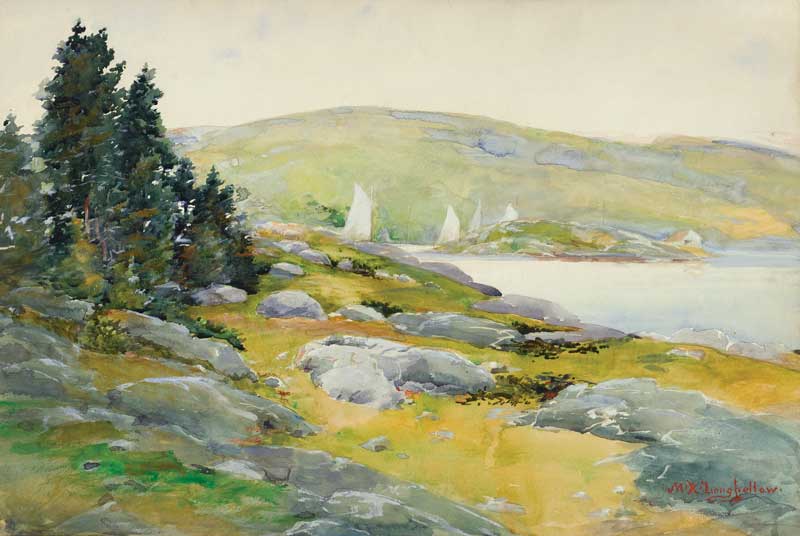 Smutty Nose and Manana from Monhegan portrays one of many views Longfellow captured during her 1890 island visit. Image courtesy of the Monhegan Museum of Art & History
Smutty Nose and Manana from Monhegan portrays one of many views Longfellow captured during her 1890 island visit. Image courtesy of the Monhegan Museum of Art & History
Longfellow’s lifelong friend, Catherine Talbot (1859-1937), was seven years her junior. A native of Machias, Talbot moved to Portland as a child with her family in 1864. Her father, George F. Talbot’s success as an attorney enabled her to pursue her interest in art, and she and Longfellow traveled and painted together for many years. Their enthusiasm for watercolors reflects the popularity of this art form in post-Civil War America.
After a three-hour-and-40-minute trip on that summer morning in 1890, Longfellow, Talbot, and the other four members of their party arrived on Monhegan. Thrilled by what she saw there, Mary wrote in her journal “found Monhegan the most quaint, salt, sea-blown, primitive and delightful place imaginable. It was better than all my hopes.” The six travelers engaged four “dainty and clean” rooms at Sarah Albee’s boarding house.
 The Port of Peace (Monhegan Headland) features a quiet hillside cemetery. Collections of the Maine Historical Society,2022.129.002
The Port of Peace (Monhegan Headland) features a quiet hillside cemetery. Collections of the Maine Historical Society,2022.129.002
Between August 15 and August 28, 1890, Longfellow and Talbot devoted part of each day to sketching the varied aspects of Monhegan, including the village, the fish houses, the harbor, Manana Island, Lobster Cove, Gull Rock, and the headlands of Burnt Head and White Head. Often, they were accompanied by the other four members of their party, and on these excursions, all six women foraged for mushrooms, which they ate with their afternoon tea. They spent their evenings reading, storytelling, writing letters, and playing whist. Toward the end of her visit, Longfellow ascended the lighthouse in the hope of glimpsing the White Mountains.
Writing in her journal on August 29, 1890, that she was “very sad to leave Monhegan,” Longfellow sailed on a packet boat to Mouse Island in Boothbay Harbor. There she and her fellow travelers stayed overnight at the Samoset Hotel on their way back to Portland.
In the days that followed her return to her South Street home, Longfellow reviewed the sketchbooks from her recent trip. On September 10, 1890, she noted in her journal that she “worked over & criticized Monhegan sketches.” Whether she ever returned to Monhegan is unknown. Regardless, her 1890 visit provided her with sketches from which she made watercolors of the island for years to come. At exhibitions in Portland, Boston, New York, and Washington, D.C., she showed the following Monhegan paintings: Gull Rock (1890), Off Monhegan (1892), Monhegan Hillside (1905), Monhegan Harbor (1907), Afternoon Monhegan (1908), Monhegan (1909), and Lone Tree (1910).
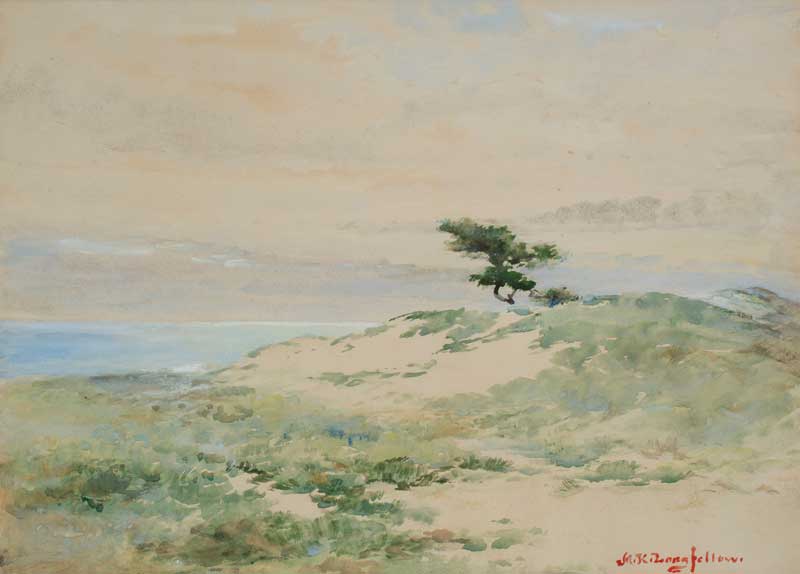 The quiet solitude of the island is palpable in this meditative watercolor, Lone Tree, Monhegan. (At right) Collections of the Maine Historical Society, 2023.122.001
The quiet solitude of the island is palpable in this meditative watercolor, Lone Tree, Monhegan. (At right) Collections of the Maine Historical Society, 2023.122.001
Mary’s pictures of the island were well-received by the public and the press. Typical of her newspaper reviews were the comments of the Washington, D.C., Evening Star on November 18, 1905, that “Miss M.K. Longfellow of Portland, Me., a niece of the poet, contributes an attractive Monhegan Hillside.” Her watercolor of the village and the harbor with Manana Island in the background was reproduced in color for the frontispiece of Kosmos, a 1910 literary magazine published by Portland women to raise funds for tuberculosis patients.
Today, examples of Longfellow’s watercolors are owned by the Maine Historical Society, the Monhegan Museum, and private collectors. In these skillfully rendered scenes of the harbor, the village, Lobster Cove, and the headlands, we see why a period art critic wrote that “Mary K. Longfellow is attracting wide notice as a painter of picturesque harbor views, made in light watercolors.”
Longfellow’s 1890 visit to Monhegan marked the beginning point for generations of talented women artists, from Maude Briggs Knowlton to Jacqueline Hudson, who have found the island “better than all my hopes.”
✮
Earle G. Shettleworth Jr. is the Maine State Historian. The author wishes to acknowledge the assistance of Stephen S. Fuller and Susan D. Bateson in preparing this article. Mary King Longfellow’s 1890 journal is owned by the Longfellow House-Washington’s Headquarters National Historic Site, which is administered by the National Park Service.
Related Articles
Share this article:
2023 Maine Boat & Home Show

Join Us for the Maine Boat & Home Show!
Art, Artisans, Food, Fun & Boats, Boats, Boats
August 11 - 13, 2023 | On the waterfront, Rockland, Maine
Click here to pre-order your tickets.
Show is produced by Maine Boats, Homes & Harbors magazine.








